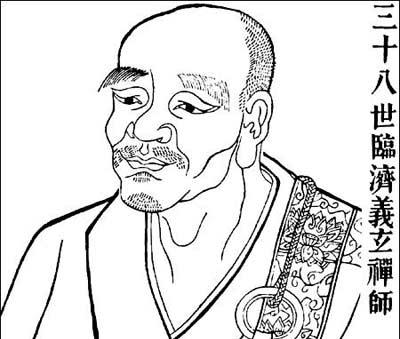Bodhidharma
Baizhang Huaihai
Caoshan Benji
Dahui Zonggao
Daman Hongren
Danxia Tianran
Dayi Daoxin
Dazhao Puji
Dazhu Huihai
Dazu Huike
Deshan Xuanjian
Dongshan Liangjie
Dōgen
Eisai
Guifeng Zongmi
Guishan Lingyou
Guizong Zhichang
Heze Shenhui
Hongzhi Zhengjue
Huangbo Xiyun
Huanglong Huinan
Huineng
Jinshan tanying
Linji Yixuan
Longtan Chongxin
Luohan Guichen
Mazu Daoyi
Nanquan Puyuan
Nanta Guangyong
Nanyang Huizhong
Nanyue Huairang
Niutou Farong
Qingliang Wenyi
Qingyuan Xingsi
Sengcan
Shishuang Chuyuan
Shitou Xiqian
Tianhuang Daowu
Xiangyan Zhixian
Xitang Zhizang
Xuansha Shibei
Xuedou Chongxian
Xuefeng Yicun
Yangqi Fanghui
Yangshan Huiji
Yantou Quanhuo
Yaoshan Weiyan
Yongjia Xuanjue
Yongming Yanshou
Yunmen Wenyan
Yunyan Tansheng
Yuquan Shenxiu
Zhaozhou Congshen
Index
Linji Yixuan

born
?
died
866
died place
jiangxi, China
ACHV
Founder of Linji House
religion
Chan
POSTH name
Chan Master Huizhao
teacher
Huangbo Xiyun
students
Twenty-two people including Xinghua Chunjiang, sanshen Huiran, Guanxi Zhixian, etc.
works
the Record of Linji
Contents
The Record of Linji
Biography
Teaching style
References in popular culture
The Record of Linji
Information on Linji is based on the Línjì yǔlù (臨濟語錄; Japanese: Rinzai-goroku), the Record of Linji. The standard form of these sayings was not completed until 250 years after Linji's death and likely reflect the teaching of Chán in the Linji school at the beginning of the Song Dynasty rather than those of Linji's in particular.
This contains stories of his interactions with teachers, contemporaries, and students. The recorded lectures are a mixture of the conventional and the iconoclastic. Those who resented the iconoclasm saw Linji as “one of the most infamous Chinese Chan masters who censored traditional Buddhist practices and doctrines.” Despite the iconoclasm, however, the Línjì yǔlù reflects a thorough knowledge of the sutras. Linji's teaching-style, as recorded in the Línjì yǔlù, exemplifies Chán development in the Hongzhou school (洪州宗) of Mazu and his successors, such as Huangbo, Linji's master.
Biography
According to the Línjì yǔlù, Linji was born into a family named Xing (邢) in Caozhou (modern Heze in Shandong), which he left at a young age to study Buddhism in many places.
Also according to the Línjì yǔlù, Linji was trained by the Chan master Huángbò Xīyùn (黃蘗希運), but attained kensho while discussing Huángbò's teaching during a conversation with the reclusive monk Dàyú (大愚). Linji then returned to Huángbò to continue his training after awakening. In 851 CE, Linji moved to the Linji temple in Hebei, where he took his name, which also became the name for the lineage of his form of Chán Buddhism.
Teaching style
Iconoclasm
Linji is reputed for being iconoclastic, leading students to awakening by hitting and shouting.
Three Mysterious Gates
Chán faced the challenge of expressing its teachings of "suchness" without getting stuck into words or concepts. The alleged use of shouting and beating was instrumental in this non-conceptual expression - after the students were well-educated in the Buddhist tradition.
Linji is described as using The Three Mysterious Gates to maintain the Chán emphasis on the nonconceptual nature of reality, while employing sutras and teachings to instruct his students:
◦The First Gate is the "mystery in the essence", the use of Buddhist philosophy, such as Yogacara to explain the interpenetration of all phenomena.
◦The Second Gate is the "mystery in the word", using the Hua Tou for "the process of gradually disentangling the students from the conceptual workings of the mind".
◦The Third Gate is the "mystery in the mystery", "involving completely nonconceptual expressions such as striking or shouting, which are intended to remove all of the defects implicit in conceptual understanding".
References in popular culture
The titular story of Volume 2 of Kazuo Koike & Goseki Kojima's manga comic Lone Wolf and Cub revolves around Linji's saying "if you meet a buddha, kill the buddha," in which the protagonist must overcome his self to assassinate a living buddha.
In the manga Gensōmaden Saiyūki by Kazuya Minekura, Genjō Sanzō purports to live by the concept of "無一物 (muichimotsu)," as taught by his teacher Sanzō Kōmyō.
Contact us
Disclaimer
Comments
© Copyright Jumpypixels.com